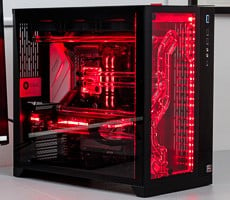Maxon's Cinebench R11.5 benchmark is based on the company's Cinema 4D software used for 3D content creation and tests both the CPU and GPU in separate benchmark runs. On the CPU side, Cinebench renders a photorealistic 3D scene by tapping into up to 64 processing threads (CPU) to process more than 300,000 total polygons, while the GPU benchmark measures graphics performance by manipulating nearly 1 million polygons and huge amounts of textures.
 |
| Cinebench R11.5 64-bit |
| 3D Rendering Performance |
|
It’s clear that Ivy Bridge Intel chips are affording systems an impressive performance boost over Sandy Bridge. The OpenGL score leaves something to be desired, though.
|

Futuremark 3DMark 11
|
The latest version of Futuremark's synthetic 3D gaming benchmark, 3DMark11, is specifically bound to Windows Vista and 7-based systems because it uses the advanced visual technologies that are only available with DirectX 11, which isn't available on previous versions of Windows. 3DMark11 isn't simply a port of 3DMark Vantage to DirectX 11, though. With this latest version of the benchmark, Futuremark has incorporated four new graphics tests, a physics tests, and a new combined test. We tested the graphics cards here with 3DMark11's Performance preset option, which uses a resolution of 1280x720. |
The Monster’s score here is disappointing compared to most of the other systems in this test, and it would appear that the GeForce GT 650M is again at fault. The system kept pace with a couple of Sandy Bridge builds running similarly classed GPUs, but was otherwise unimpressive.







